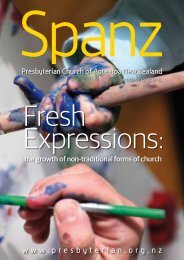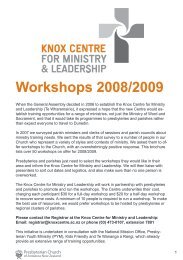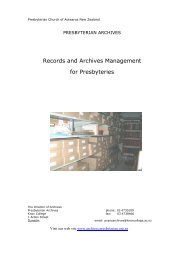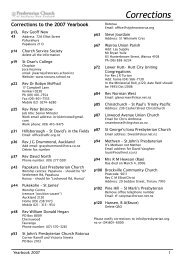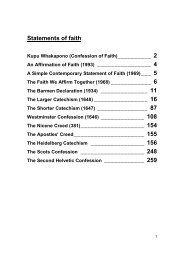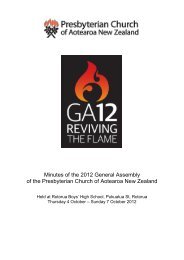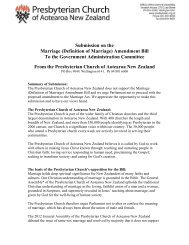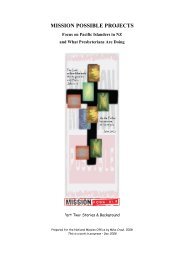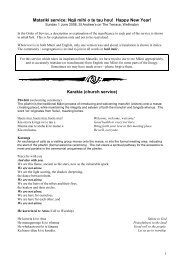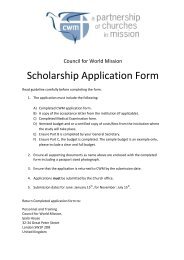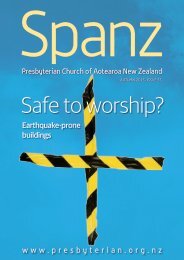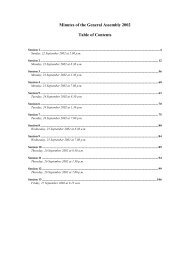Cultural diversity and unity in Christ: the Presbyterian Church of ...
Cultural diversity and unity in Christ: the Presbyterian Church of ...
Cultural diversity and unity in Christ: the Presbyterian Church of ...
Create successful ePaper yourself
Turn your PDF publications into a flip-book with our unique Google optimized e-Paper software.
As we have seen <strong>the</strong> church is to be a sign <strong>of</strong> God’s mission <strong>of</strong> reconcil<strong>in</strong>g all humanity to Godself<br />
<strong>and</strong> to one ano<strong>the</strong>r <strong>in</strong> <strong>Christ</strong> <strong>and</strong> table fellowship is <strong>the</strong> outward <strong>and</strong> visible expression <strong>of</strong> that, a<br />
foretaste <strong>of</strong> <strong>the</strong> eschatological banquet <strong>of</strong> <strong>the</strong> people <strong>of</strong> God. “Because <strong>the</strong> fellowship <strong>of</strong> <strong>the</strong> table<br />
unites believers with <strong>the</strong> triune God though <strong>Christ</strong>, it also causes [persons] to unite with one ano<strong>the</strong>r<br />
<strong>in</strong> messianic fellowship. The common bread <strong>and</strong> <strong>the</strong> common cup po<strong>in</strong>t to <strong>the</strong> oneness <strong>of</strong> <strong>the</strong> people<br />
who partake <strong>in</strong> <strong>the</strong> one <strong>Christ</strong>, <strong>and</strong> <strong>in</strong> him with participants at all times <strong>and</strong> <strong>in</strong> all places… The open<br />
<strong>in</strong>vitation <strong>of</strong> <strong>the</strong> crucified one to his supper is what fundamentally overcomes all tendencies toward<br />
alienation, separation <strong>and</strong> segregation. For through giv<strong>in</strong>g himself up to death for <strong>the</strong> fellowship <strong>of</strong><br />
[people] with God <strong>and</strong> with one ano<strong>the</strong>r, <strong>the</strong> godless <strong>and</strong> <strong>in</strong>human divisions <strong>and</strong> enmities between<br />
races, nations, civilization <strong>and</strong> classes are overcome. <strong>Church</strong>es which permit <strong>the</strong>se deadly divisions <strong>in</strong><br />
<strong>the</strong>mselves are mak<strong>in</strong>g <strong>the</strong> cross <strong>of</strong> <strong>Christ</strong> a mockery.” 72 Unfortunately many <strong>of</strong> <strong>the</strong> churches which<br />
have separate ethnic congregations with<strong>in</strong> <strong>the</strong>m have been unable to even agree to work toge<strong>the</strong>r so<br />
<strong>the</strong>y can worship as one on <strong>the</strong> occasions <strong>the</strong>y celebrate communion.<br />
It is clear that it is critical for <strong>the</strong> future <strong>of</strong> <strong>Christ</strong>ianity <strong>in</strong> societies like NZ, as immigration trends<br />
move us toward becom<strong>in</strong>g an <strong>in</strong>creas<strong>in</strong>gly multicultural society, that we <strong>in</strong> <strong>the</strong> church are committed<br />
to form<strong>in</strong>g churches that are <strong>in</strong>tercultural or cross cultural communities, <strong>and</strong> <strong>in</strong> that way may be a sign<br />
to an <strong>in</strong>creas<strong>in</strong>gly fragmented world <strong>of</strong> what God <strong>in</strong> <strong>Christ</strong> is able to do. This is not to argue that every<br />
church <strong>in</strong> every place should be cross cultural <strong>in</strong> this way, as some churches are still located <strong>in</strong><br />
contexts which are largely homogenous. However this is <strong>in</strong>creas<strong>in</strong>gly less <strong>the</strong> case, even <strong>in</strong> many <strong>of</strong><br />
our rural communities. At <strong>the</strong> same time we also need to remember that we move <strong>in</strong>to this from our<br />
commitment to be<strong>in</strong>g bicultural. In light <strong>of</strong> this some affirmations at <strong>the</strong> past two General Assemblies<br />
have been encourag<strong>in</strong>g, <strong>and</strong> some <strong>of</strong> <strong>the</strong> moments at <strong>the</strong> 2012 GA significant. In seek<strong>in</strong>g to work<br />
toward a structure that best enabled <strong>the</strong> Pacific Isl<strong>and</strong> comm<strong>unity</strong> to f<strong>in</strong>d a turangawaewae with<strong>in</strong> it,<br />
<strong>the</strong> 2010 Assembly affirmed “its commitment to <strong>the</strong> embodiment <strong>of</strong> <strong>the</strong> bicultural <strong>and</strong> multicultural<br />
church” <strong>and</strong> <strong>in</strong> 2012 <strong>the</strong> Pacific Isl<strong>and</strong> Synod was granted Presbytery status. The 2012 Assembly also<br />
affirmed a motion from <strong>the</strong> Asian Council that it work toward becom<strong>in</strong>g a “cross cultural church<br />
with<strong>in</strong> <strong>the</strong> context <strong>of</strong> a bicultural church” as it sought to move to f<strong>in</strong>d<strong>in</strong>g its own place to st<strong>and</strong>.<br />
Comment<strong>in</strong>g on this, Stuart Vogel, a member <strong>of</strong> <strong>the</strong> Asian Council, said that “<strong>the</strong> <strong>Presbyterian</strong> <strong>Church</strong><br />
has decided to beg<strong>in</strong> <strong>the</strong> process <strong>of</strong> becom<strong>in</strong>g an active, vibrant cross-cultural church.”<br />
Mov<strong>in</strong>g forward<br />
In try<strong>in</strong>g to f<strong>in</strong>d some def<strong>in</strong>ition <strong>of</strong> a multicultural church, most researchers set a figure <strong>of</strong> no more<br />
than 80% <strong>of</strong> a church’s population be<strong>in</strong>g made up <strong>of</strong> anyone ethnic group. Even allow<strong>in</strong>g for this<br />
fairly generous limit remarkably few churches qualify. However a truly cross cultural church is more<br />
than just hav<strong>in</strong>g different ethnic groups <strong>in</strong>habit<strong>in</strong>g <strong>the</strong> same space. One helpful def<strong>in</strong>ition I have found<br />
is this: “A multicultural congregation is one that is made up <strong>of</strong> a variety <strong>of</strong> cultures <strong>and</strong> ethnic groups,<br />
which actively contributes to <strong>the</strong> leadership, direction, worship, style <strong>and</strong> ethos <strong>of</strong> <strong>the</strong> church, <strong>and</strong><br />
share its power, f<strong>in</strong>ances <strong>and</strong> resources.” 73<br />
For reflection/discussion<br />
Th<strong>in</strong>k about your church <strong>in</strong> <strong>the</strong> light <strong>of</strong> this def<strong>in</strong>ition. To what extent does its makeup reflect <strong>the</strong><br />
makeup <strong>of</strong> your comm<strong>unity</strong>? Th<strong>in</strong>k about <strong>the</strong> leadership <strong>of</strong> <strong>the</strong> church. What ethnic groups who are<br />
part <strong>of</strong> <strong>the</strong> church are miss<strong>in</strong>g from it? In terms <strong>of</strong> worship, how much do <strong>the</strong> variety <strong>of</strong> cultural<br />
groups contribute to what happens?<br />
In a helpful book on culturally diverse congregations, Charles Foster outl<strong>in</strong>es four different practices<br />
that churches have taken <strong>in</strong> negotiat<strong>in</strong>g <strong>the</strong> dynamics <strong>of</strong> relationship between groups as racial <strong>and</strong><br />
cultural <strong>diversity</strong> develops <strong>in</strong> <strong>the</strong>ir context.<br />
Sponsor<strong>in</strong>g congregations. It is relatively easy today to f<strong>in</strong>d churches that provide a space for at<br />
least one o<strong>the</strong>r congregation or m<strong>in</strong>istry for a group different from <strong>the</strong>ir own. When churches do<br />
72 Jurgen Moltmann, The <strong>Church</strong> <strong>in</strong> <strong>the</strong> Power <strong>of</strong> <strong>the</strong> Spirit (London: SCM, 1977) 257-8.<br />
73 Ross Langmead, “Why Multicultural Congregations?”, an unpublished paper presented at <strong>the</strong> Australian <strong>and</strong><br />
New Zeal<strong>and</strong> Association <strong>of</strong> Theological Schools Conference, Brisbane, Australia, July 2012.<br />
19



